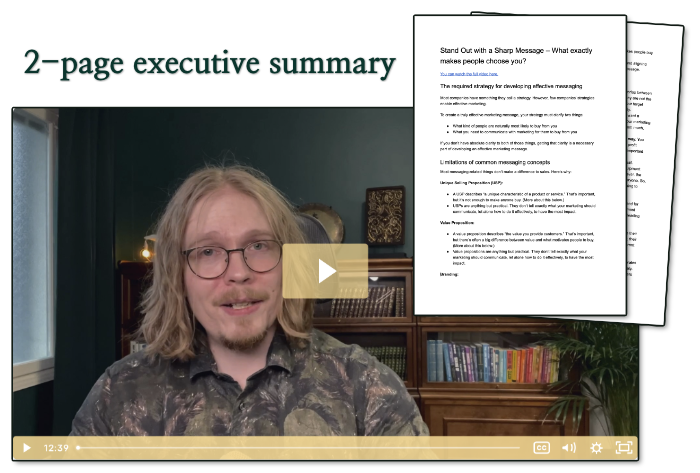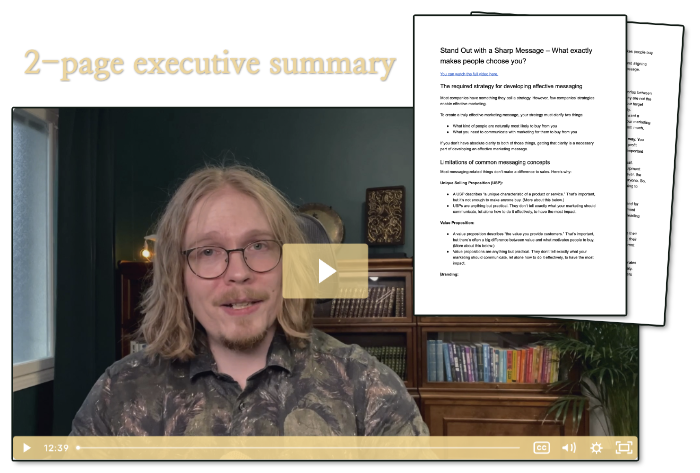Defining your target customer is typically the first step when planning marketing. And that’s been the case for decades.
The traditional approach to targeting hasn’t changed much. Ask anyone with a traditional marketing or business education, and they can recite the steps like the alphabets.
There’s clearly plenty of value in defining your target customer the traditional way. However, that doesn’t mean it’s all you need if you want to do effective marketing.
Traditional target customer
The traditional approach aims to answer “Where will you find them and how will you recognize them?”
The main questions to answer are things like (some for B-to-B, others for B-to-C, some for both):
- What’s their revenue?
- Where are they located / where do they live?
- What industry are they in?
- How many employees do they have?
- How much money do they make?
- What education level do they have?
- How good are they at golf/cooking/etc.?
These are useful things to know. For example, you can choose whom to send your direct mail ads to. And you can figure out which TV shows they’re most likely to watch and have your ads run during those shows.
And most obviously, this sort of targeting is used by salespeople who need to figure out whom to cold call.
Those questions can also help figure out your messaging—what you need to communicate, so people want to buy. But they aren’t meant for that, and their impact on messaging is usually very slight.
My approach to defining your target customer
The key question is, “What is their perspective to what you sell?”
If you sell golf clubs, what do they think about golf, their swing, etc.? What do they think are the reasons they can’t get better scores? What do they want from golfing? And so on.
If you sell an accounting software, what do they find frustrating about their current software? What problems do they have related to payroll? What sort of expectations do they have related to accounting software? And so on.
Those types of questions help you find out what could make them see value in what you sell and want to buy.
My primary service is developing value propositions (or rather, a more practical version of those, which I call Stand Out Messages). In practice, it means figuring out what exact ideas/beliefs would make people see the value in what you sell and want to buy it. So, I have to define your target customer based on their perspective.
In other words, your target customers are people who share the same perspective. If they’d have different perspectives to what you sell, they’d need to see different things to want to buy from you.
Sometimes their revenue, location, industry, skill, etc. make a big difference to their perspective. And even if they don’t make a difference to your messaging, you should still know the answers to the traditional targeting questions. Just don’t expect those to be enough for effective messaging.
Problems of traditional targeting
Here are a few of the common problems people face when they try to figure out their value proposition, messaging, or what they should say in their marketing (all basically the same thing), but they’ve only defined their target customer the traditional way:
- “We know the value people get from us, but we can’t figure out how to condense it.”
- “We need to say different things to each prospect.”
- “Our marketing doesn’t have a clear message. It’s just general info about our products/services.”
- “Most people we talk with understand the value we provide, but it takes 15 minutes or longer to get there.”
- “Even the people who understand how valuable our products/services would be for them end up buying from our competitors.”
If you don’t know what to say to make people want what you sell, it’s going to be hard to make sales. Maybe you’ll make some sales with great effort. But that’s not scalable, predictable, or usually even sustainable.
The first thing you’ll need to do is define your target customer—based on their perspective, not based on how you categorize them. Don’t try to use the traditional target customer exercises for something they aren’t meant for.
Want to define your target customer and know what to say in marketing?
Defining your target customer is the first step in creating a strong value proposition, so I do it all the time. If you’re interested, get in contact, so we can talk. Maybe I’m the right person to help you—and if not, at least I can give some new perspective to your situation.


